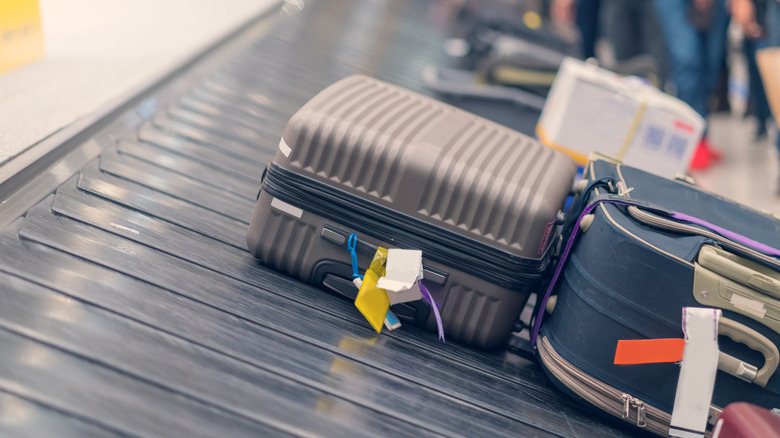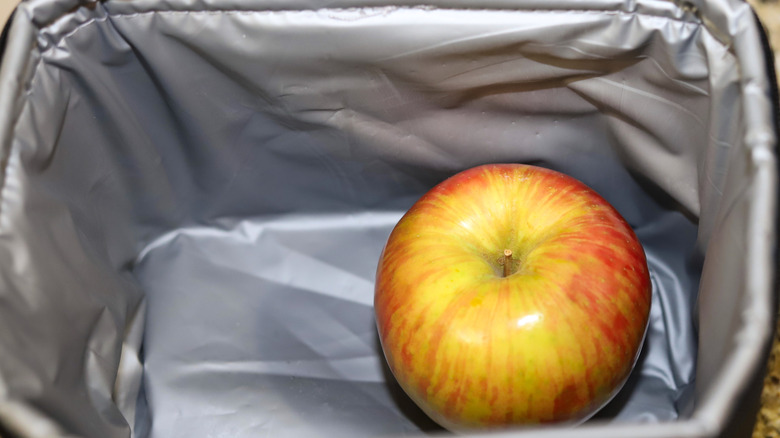Why It's A Bad Sign If You See A Zip Tie On Your Luggage
When you take carry-on luggage to an airport, it's going to be extensively screened. Your bag will travel through an X-ray machine, and if the Transportation Security Administration (TSA) views anything they deem suspicious, it will be pulled and searched, with any restricted items being discarded prior to you regaining possession of your items.
Checked luggage, on the other hand, is not held to the same standard. In fact, most passengers never see any screening performed on the luggage they check, other than it being weighed at the counter. This does not mean checked luggage isn't screened by security — it absolutely is, and the appearance of a zip tie on your checked luggage likely indicates it was tagged for additional screening or search.
Although checked luggage is not held to the same rules as carry-on luggage (for example, you can check liquids exceeding 3.4 oz.), that doesn't mean you can pack whatever you want. TSA outlines a lengthy list of prohibited items to check on their website, and should you neglect to check and see if you're packing any restricted items, you run the risk of mistakenly packing something that can get your bag flagged and tagged — possibly with one of those dreaded zip ties.
How can additional screening of your checked bag affect you?
One Australian tourist was left wondering why there was a zip tie attached to her bag after arriving in Bali. She did what many people do when they're confused and want a question answered quickly — she got on Facebook. "Does anyone know what this cable tie on our bags means? Arrived last night and one bag took a bit longer and came out with this tag. I'm guessing it was inspected?" the traveler inquired in the Bali Bogans Facebook group (via The Sun). The answers she received were less than reassuring.
Most people in the group asserted that zip ties on their own luggage had indeed meant not just additional screening, but also fines for bringing prohibited items. "Oh no gives me nightmares these cable ties! I got pulled up back in 2019," one user shared. "Mine was green and they pulled me up and searched and charged me $300 AUD (£177)." Another user informed the group they were searched for carrying lactose-free life long milk.
One way to avoid the pitfalls of having a checked bag receive additional screening is to pack just one carry-on for a week-long vacation, but if you're unable to do that and do happen to find a zip tie on one of your items, you may also notice it took longer to get that item back. When a bag is tagged for additional screening, it will likely be one of the last pieces of luggage to hit the baggage claim, since an extra search takes more time. On top of the inconvenience of waiting longer, if a prohibited item is indeed found, depending upon the category of offense, you may also be looking at a fine.
What items can you travel with in checked luggage?
TSA files restricted items into the three categories of prohibited, accepted with special instruction, and check with individual carriers, meaning the airline you're traveling with. Some prohibited items like dynamite, fireworks, and gunpowder seem like common sense, but others aren't as cut and dry, and may be found more readily in the bags of less savvy travelers. Cordless curling irons, lighters and matches, lithium batteries with more than 100 watt hours, and power banks are all prohibited items. Lithium batteries can be especially tricky, as they're found in laptops and even built into some carry-on bags as a power source for charging personal electronics. This is why when a plane runs out of space in the overhead bins and your bag has to be checked unexpectedly, the flight attendant will first ask you if the bag contains a laptop or any lithium batteries.
Popular items that may be carried in checked luggage but require special instruction include hairspray, nail polish, curling irons with a cord, electric toothbrushes, and bug repellant – all things the average traveler may need on vacation. One strategy is to skip packing these items all together and opt to buy them instead once you reach your destination. Less common items like dry ice, hover boards, and Segways may be accepted by some airlines, but not all. To save yourself the trouble of unexpected additional screening, it's best practice to consult the TSA website and search their restricted item list for anything you may be unsure about before you pack your bags for your next vacation.
Restricted travel items vary by international destination
There are any number of known airport hacks to help you zip through TSA, which is part of the United States Department of Homeland Security, but what happens when you're checking a bag that will arrive in another country? It will be subject to the custom rules of that new country, meaning international travelers need to look beyond the TSA website for packing restrictions.
If you're traveling internationally, you must keep in mind that you will be passing through the customs of a different country or countries, and things as innocuous as fruits, vegetables, and other fresh food items may not be permitted to enter the country, even if they passed through TSA in the United States. For example, New Zealand is very restrictive when it comes to food and grains, with the idea that keeping international pests away from their unique ecosystem is of the utmost importance. And you may not be off the hook even if you're only traveling domestically — Hawaii, Puerto Rico, and the U.S. Virgin Islands have additional restrictions for the same reason.



